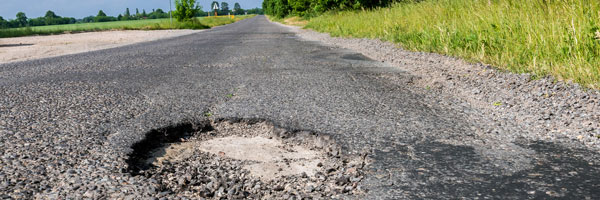
Potholes are one of the most common road hazards. It’s important for every driver to know how to avoid them, drive over them, report them and take care of their vehicle when damage happens.
Here’s your guide to driving safer with potholes.
How to safely avoid potholes
It’s always better to avoid hitting a pothole in the first place. Make it easier by following these tips:
Drive cautiously.
Increase the distance between you and the vehicle in front of you. This can help you spot a pothole sooner and avoid it. It is also safer to increase your following distance in case the vehicle in front of yours suddenly maneuvers to avoid a pothole.Improve your visibility.
Look into the distance at the road ahead of you and the car ahead of you to better see and navigate around upcoming potholes. Make sure your headlights are working and your windshield is clean and clear for better visibility at night.Watch out for puddles.
If you can do it safely, avoid driving over puddles. An innocent-looking puddle could be a pothole filled with water.Avoid other vehicles.
Never swerve into an occupied lane, which could result in a collision with another vehicle.
Minimize car damage when driving over potholes
Sometimes you can’t avoid hitting a pothole, but there are things you can do to help minimize the damage to your vehicle when driving over a pothole.
Slow down, then coast.
It’s best to slow down before a pothole, and then release the brakes before you hit it. If you apply the brakes while your car is in the pothole it can cause more damage to your vehicle. It’s better to slow down and then coast over a pothole if you can’t avoid hitting it because it reduces the speed at impact and allows your suspension to travel its full range to absorb the impact.Drive slowly.
If you’re driving on a street that’s covered in potholes, driving slowly will give you more time to maneuver around potholes and be gentler on your vehicle as you hit them.Firmly hold the steering wheel.
You’re more at risk of losing control of your vehicle when you drive over a pothole. If you can’t avoid hitting a pothole, grip your steering wheel firmly so you can maintain control.Hit it squarely.
Straighten your wheel to hit the pothole squarely and roll through it. If you hit a pothole at an angle, it’s more likely to damage your vehicle.Maintain your suspension.
Before you hit a pothole, you can help minimize damage by having your vehicle’s suspension checked regularly by a qualified auto mechanic. Your vehicle’s shocks, struts and springs help cushion the impact. Keep tires properly inflated.
Over- and under-inflated tires fare worse when they come in contact with a pothole. Tires with excessive wear or bulges in the sidewalls also will not perform well when they encounter a pothole.

Learn about our
Auto Insurance
Check your car for pothole damage
Wheel and tire damage are common types of vehicle damage from potholes. Carefully check your tires for damage. Here are some other things to look for:
- Does your car now pull one way or the other? You may need to have your steering realigned.
- Does your car now “bottom out” or bounce? You may need to have your suspension repaired.
If you’re concerned at all about the safety of your vehicle after hitting a pothole, it’s best to have your vehicle checked out by a qualified auto mechanic, and if necessary, repaired.
Who is responsible when you hit a pothole?
In most cases, you are responsible when you hit a pothole.
However, some cities and states allow drivers to request reimbursement for pothole damage. If you’d like to research this, find out what jurisdiction is responsible for the road where the pothole is located and inquire about compensation for pothole damage.
Another neighborly thing to do after spotting or hitting a pothole is to contact the city’s public works department or state’s department of transportation, depending on who manages the road with the pothole, and requesting a road repair.
Does car insurance cover pothole damage?
Yes, pothole damage is usually covered by auto insurance if you have collision coverage. Collision coverage is activated when your car damage is the result of hitting an object, like a pothole. However, collision coverage does not cover wear and tear to a car or its tires resulting from poor road conditions.
Your auto insurance policy’s liability coverage could also come into play if you accidentally hit another car or pedestrian due to a pothole.
Because the cost to repair pothole damage to your vehicle might be less than your auto insurance deductible (the amount of money deducted from your claim payment), it may or may not make sense to file an auto insurance claim to cover repair costs. Check the amount of your deductible on your auto insurance policy and compare it to a repair shop estimate. Or speak with your independent insurance agent for the best advice on when to file a claim. Your agent can also help you begin the claim process, if needed.
This article is for informational and suggestion purposes only. If the policy coverage descriptions in this article conflict with the language in the policy, the language in the policy applies. Talk to your local independent agent to learn more about Grange auto insurance.
References:
- Automotive Fleet
- Michigan Department of Transportation
- Insurance Information Institute
- Firestone